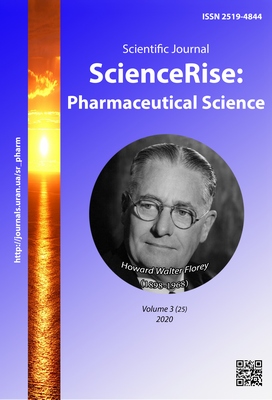Розробка та валідація метода одночасного визначення бензидаміну гідрохлориду та метилпарабену в готовому лікарському засобі методом ВЕРХ
DOI:
https://doi.org/10.15587/2519-4852.2020.206579Ключові слова:
ВЕРХ, бензидамін гідрохлорид, метилпарабен, валідація методу, одночасне визначення.Анотація
Мета дослідження. Метою даної роботи було розробити та затвердити метод ВЕРХ для одночасного визначення бензидаміну гідрохлориду (АФІ) та метилпарабену (консервант) у лікарській формі, що містить бензидамін гідрохлорид як активний фармацевтичний інгредієнт.
Методи. Розділення проводили на колонці Grace Altima C18 (250 мм * 4,6 мм, розмір частинок 5 мкм). Рухома фаза складалася з 3,0 г перхлорату натрію, 1 мл триметиламіну і доводилася до рН 3 перхлорною кислотою. Швидкість потоку рухомої фази становила 1 мл / хв, довжина хвилі виявлення - 320 нм для гідрохлориду бензидаміну та 254 нм для метилпарабену.
Результати. Метод був перевірений відповідно до вимог ICH Q2 і визнаний надійним, специфічним, лінійним в діапазоні від 80 % до 120 % для аналізованої речовини. Максимальне RSD для кожного з'єднання становило менше 1.3 %. Точність методу була в межах критеріїв прийнятності.
Висновки. Метод одночасного визначення бензидаміну гідрохлориду та метилпарабену був розроблений і затверджений відповідно до вимог Міжнародної конференції з гармонізації. Всі параметри валідації відповідають критеріям прийнятності керівництва.
Розроблений метод може бути застосований в рутинному контролі в лабораторіях контролю якості для одночасного визначення бензидаміну гідрохлориду та метилпарабену в лікарських формах бензидаміну.
Посилання
- Turnbull, R. S. (1995). Benzydamine Hydrochloride (Tantum) in the management of oral inflammatory conditions. Journal of the Canadian Dental Association, 61 (2), 127–134.
- British pharmacopoeia. Vol. 1 (2018). London: Medicines and Healthcare products Regulatory Agency, 265.
- British pharmacopoeia. Vol. 3 (2018). London: Medicines and Healthcare products Regulatory Agency, 181.
- Dogan, A., E. Bascı, N. (2011). Development and Validation of RP-HPLC and Ultraviolet Spectrophotometric Methods of Analysis for the Quantitative Determination of Chlorhexidine Gluconate and Benzydamine Hydrochloride in Pharmaceutical Dosage Forms. Current Pharmaceutical Analysis, 7 (3), 167–175. doi: http://doi.org/10.2174/157341211796353228
- Catanese, B., Lagana, A., Marino, A., Picollo, R., Rotatori, M. (1986). HPLC determination of benzydamine and its metabolite N-oxide in plasma following oral administration or topical application in man, using fluorimetric detection. Pharmacological Research Communications, 18 (4), 385–403. doi: http://doi.org/10.1016/0031-6989(86)90091-3
- Benson, H. A. E., McElnay, J. C. (1987). High-performance liquid chromatography assay for the measurement of benzydamine hydrochloride in topical pharmaceutical preparations. Journal of Chromatography A, 394 (2), 394–399. doi: http://doi.org/10.1016/s0021-9673(01)94193-7
- Shabir, G. (2010). A new validated HPLC method for the simultaneous determination of 2-phenoxyethanol, methylparaben, ethylparaben and propylparaben in a pharmaceutical gel. Indian Journal of Pharmaceutical Sciences, 72 (4), 421–425. doi: http://doi.org/10.4103/0250-474x.73906
- M. Kashid, R., G. Singh, S., Singh, S. (2011). Simultaneous Determination of Preservatives (Methyl Paraben and Propyl Paraben) in Sucralfate Suspension Using High Performance Liquid Chromatography. E-Journal of Chemistry, 8 (1), 340–346. doi: http://doi.org/10.1155/2011/360431
- Turabi, Z. M., Khatatbeh, O. A., Al-Abed, D. N. (2014). RP-HPLC Method Development and Validation for the Simultaneous Determination of Mebendazole and the Two Preservatives Methylparaben and Propylparaben in Pharmaceutical Oral Suspension Dosage Form. International Journal of Pharmaceutical Sciences and Drug Research, 6 (1), 70–74.
- Koel, M., Kaljurand, M. (2006). Application of the principles of green chemistry in analytical chemistry. Pure and Applied Chemistry, 78 (11), 1993–2002. doi: http://doi.org/10.1351/pac200678111993
- He, Y., Tang, L., Wu, X., Hou, X., Lee, Y. (2007). Spectroscopy: The Best Way Toward Green Analytical Chemistry? Applied Spectroscopy Reviews, 42 (2), 119–138. doi: http://doi.org/10.1080/05704920601184259
- Płotka-Wasylka, J., Gałuszka, A., Namieśnik, J.; Płotka-Wasylka, J., Namieśnik, J. (Eds.) (2019). Green Analytical Chemistry: Summary of Existing Knowledge and Future Trends. Green Analytical Chemistry. Green Chemistry and Sustainable Technology. Singapore: Springer, 431–449. doi: http://doi.org/10.1007/978-981-13-9105-7_15
- Bhandari, M., Raj, S. (2017). Practical approach to green chemistry. International Journal of Pharmacy and Pharmaceutical Sciences, 9 (4), 10–26. doi: http://doi.org/10.22159/ijpps.2017v9i4.15640
- Validation of analytical procedures Q2 R1 (2005). International Conference on Harmonization. Available at: https://database.ich.org/sites/default/files/Q2_R1__Guideline.pdf
- Eldin, A., Ismaiel, O., Hassan, W., Shalaby, A. (2015). Development and validation of stability indicating green HPLC-UV method for determination of Cephalexin in pharmaceutical dosage forms and human urine using micellar mobile phase. International Journal of Pharmacy and Pharmaceutical Sciences, 7 (9), 122–127. Available at: https://innovareacademics.in/journals/index.php/ijpps/article/view/5950
- United States Pharmacopeial Convention. General chapter: Validation of compendial procedures. Rockville: United States Pharmacopeial Convention.
- Kozakevich, Y., Lobrutto, R. (2007). HPLC for pharmaceutical scientists. New Jersey: John Wiley and Sons. doi: http://doi.org/10.1002/0470087951
- Grossman, R. B., Finkel, R. (2017). ACE and JChem acidity and basicity calculator, ACE UKY-4.2 & Marvin JS by ChemAxon: Perfluorononane-sulfonic acid. Lexington: University of Kentucky & Pearson Education.
- Weast, R. C. (1985–1986). Handbook of Chemistry and Physics. Florida: CRC Press Inc.
- LoBrutto, R. (2000). Retention of Ionizable Compounds in HPLC. Available at: https://scholarship.shu.edu/dissertations/1240
##submission.downloads##
Опубліковано
Як цитувати
Номер
Розділ
Ліцензія
Авторське право (c) 2020 Vasyl Chornyi, Olga Chorna, Victoriya Georgiyants

Ця робота ліцензується відповідно до Creative Commons Attribution 4.0 International License.
Наше видання використовує положення про авторські права Creative Commons CC BY для журналів відкритого доступу.









